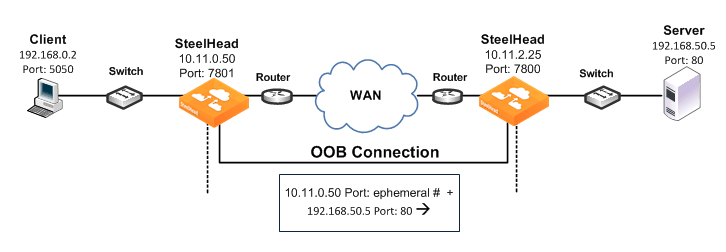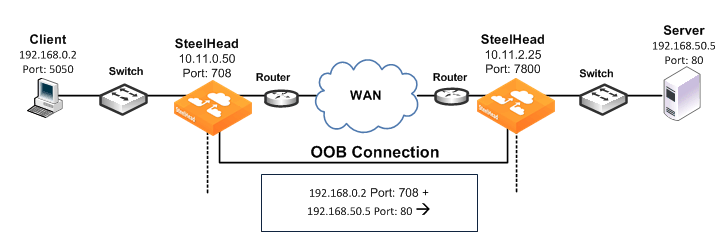The Out-of-Band Connection
This section describes transparency options for the out-of-band (OOB) connection. This section includes the following topics:
Overview of OOB Connections and Addressing ModesConfiguring OOB Connection Destination TransparencyConfiguring OOB Connection Full TransparencyOverview of OOB Connections and Addressing Modes
A SteelHead OOB connection is a TCP connection that SteelHeads establish with each other when they begin optimizing traffic to exchange capabilities and feature information, and to detect failures. A SteelHead creates an OOB connection for each pair of local and remote in-path interfaces that are used when optimizing connections. OOB connections are created by the SteelHead closest to the initiating side of the optimized connection.
The addresses and ports used by OOB connections depend on the addressing mode used for the first optimized connection between SteelHeads. If the addressing mode for the first connection is correct addressing or port transparency, the OOB connection uses correct addressing. If the first connection is full transparency, the default behavior is to make the OOB connection use correct addressing, but you can alter this behavior such that the connection uses a form of network transparency.
In some environments, it might be necessary to make OOB connections use some form of network transparency: for example, is network is unable to route between the in-path IP addresses or VLANs of SteelHeads that are optimizing traffic. Two options for OOB transparency exist:
Destination transparencyFull transparency Configuring OOB Connection Destination Transparency
Figure 3‑15 shows TCP/IP packet headers when OOB connection destination transparency is enabled.
Figure 3‑15. OOB Connection Destination Transparency

OOB connection destination transparency uses the following values in the TCP/IP packet headers in both directions across the WAN:
Client-side SteelHead IP address and an ephemeral port number chosen by the client-side SteelHead + server IP address and port number.SteelHeads use the server IP address and port number from the first optimized connection. Use OOB connection destination transparency if the client-side SteelHead cannot establish the OOB connection to the server-side SteelHead.
You must first configure WAN visibility full address transparency for OOB connection destination transparency to function correctly.
To enable OOB connection destination transparency
Connect to the CLI on the client-side SteelHead and enter the following commands:enable
configure terminal
in-path peering oobtransparency mode destination
write memory
The changes take effect immediately. You must save your changes or they are lost upon reboot.
To disable OOB connection destination transparency
Connect to the Riverbed CLI on the client-side SteelHead and enter the following commands:enable
configure terminal
in-path peering oobtransparency mode none
write memory
The changes take effect immediately. You must save your changes or they are lost upon reboot.
Configuring OOB Connection Full Transparency
Figure 3‑16 shows TCP/IP packet headers when OOB connection full transparency is enabled.
Figure 3‑16. OOB Connection Full Transparency

OOB connection full transparency uses the following values in the TCP/IP packet headers in both directions across the WAN:
Client IP address and client-side SteelHead predetermined port number 708 + server IP address and port number.SteelHeads use the client IP address, and the server IP address and port number from the first optimized connection.
If the client is already using port 708 to connect to the destination server, enter the following CLI command to change the client-side SteelHead predetermined port number:
in-path peering oobtransparency port <port number>
OOB connection full transparency supports SteelHeads deployed on trunks. Because you can configure full address transparency so that optimized traffic remains on the original VLAN, you no longer need for a SteelHead VLAN.
Use OOB connection full transparency if your network is unable to route between SteelHead in-path IP addresses or in-path VLANs, or you do not want to see SteelHead IP addresses used for the OOB connection.
You must first configure WAN visibility full address transparency for OOB connection full transparency to function correctly. For details, see
Full Address Transparency.
To enable OOB connection full transparency
Connect to the CLI on the client-side SteelHead and enter the following commands:enable
configure terminal
in-path peering oobtransparency mode full
write memory
The changes take effect immediately. You must save your changes or they are lost upon reboot.
To disable OOB connection full transparency
Connect to the CLI on the client-side SteelHead and enter the following commands:enable
configure terminal
in-path peering oobtransparency mode none
write memory
The changes take effect immediately. You must save your changes or they are lost upon reboot.



